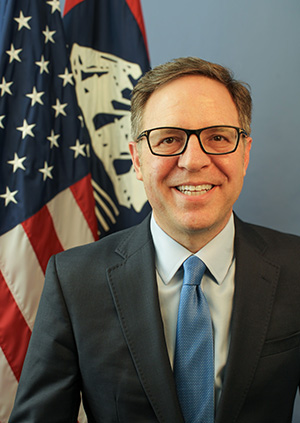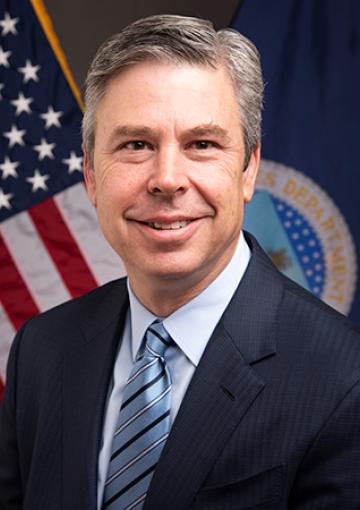The National Telecommunications and Information Administration is working its way through state-level proposals that seek grants from a $42.45 billion program aimed at building out broadband networks in underserved areas.
Four states — Kansas, Louisiana, Nevada and West Virginia — have so far gained NTIA approval of all their proposals for funding under the Broadband Equity Access and Deployment Program (BEAD). Forty-six more are awaiting approval of what are called Volume II proposals, which lay out how grants will be awarded in partnership with local broadband providers and governments.
 Alan Davidson, NTIA
Alan Davidson, NTIASix states have not yet won approval for either Volume II or Volume I proposals, which detail the state's broadband needs. However, NTIA administrator Alan Davidson told members of NTCA-The Rural Broadband Association Monday he was impressed by all of the states making the deadline to submit proposals.
“I’ll be honest, I was surprised,” he said. “I thought we’d have some stragglers.”
Davidson called the two-phased approach the agency decided to take with regard to proposals “very clever.” Breaking the proposals into parts, he said, makes it easier for NTIA and states to review and revise the applications as the process continues.
States and territories initially received $100 million in BEAD funding, but were required to submit five-year action plans to NTIA before receiving additional dollars. The remaining funds are apportioned based on the number of unserved areas every state contains, which are included in the FCC’s 2022 update of its broadband maps.
These 18 states will get more than $1 billion: California, Missouri, Michigan, North Carolina, Virginia, Alabama, Louisiana, Georgia, Washington, West Virginia, Mississippi, Florida, Pennsylvania, Kentucky, Wisconsin, Illinois, Arkansas and Alaska.
Cut through the clutter! We deliver the news you need to stay informed about farm, food and rural issues. Sign up for a FREE month of Agri-Pulse here.
States will start rolling out their funding later this year, USDA Rural Utilities Service Administrator Andy Berke said during the NTIA event. He added, however, that coordination between state and federal agencies such as RUS and NTIA would be necessary to prevent BEAD from overlapping with those funded by other programs.
“We have to strike that balance between moving projects forward, making sure that we’re fulfilling our mission, and also ensuring that we don’t waste taxpayer dollars by duplicating funding and applications,” Berke said.
With the recent influx of BEAD funding, as well as funding through other programs, Federal Communications Commission member Anna Gomez said changes need to be made to the FCC’s Universal Service Fund, which includes money collected from telecommunications companies. She said the fund, which currently provides support for four communications programs, should “evolve to be complementary” with the recent federal dollars that have been spent to expand broadband infrastructure.
 Andy Berke, USDA
Andy Berke, USDA“We need to be thinking about maintenance operations, how we can pivot the funds or utilize the funds that will also help sustain these networks that we’re spending so much money building out right now,” Gomez said.
Permitting, environmental reviews a ‘struggle’ for broadband expansion
Berke said environmental and historic preservation reviews and permitting challenge broadband expansion although federal agencies are simplifying their processes.
Permitting can be time-consuming, he noted. Environmental specialists may start a review for a project on one side of a road, but restarting the process if it moves to the opposite side of the road.
“If you saw my hair 18 months ago, it’s all brown. Permitting that has occurred has been 90% of this gray that I have,” Berke said.
Staffing also is a challenge, Berke said. Last year RUS distributed $10 billion in grants with an environmental review group of only 11 people. But the agency is increasing its number of environmental review specialists to 35.
He also said the agency is looking at creating a “fast lane” to prevent simpler projects from being held up by more complex ones.
The environmental review process is complex and requires collaboration with othere federal agencies, he said, including the Bureau of Land Management and the Forest Service. Collaboration with outside entities like state historic preservation and tribal preservation offices is often needed, he said, which can cause RUS to “hit a wall.”
Administration officials continue push for connectivity funding
FCC's Gomez echoed the Biden Administration’s recent call for more funding to support the nearly depleted Affordable Connectivity Program.
The ACP, launched in 2022 as part of the Infrastructure Investment and Jobs Act, provides $30 per month that some households can put towards their internet bills, as well as a one-time $100 subsidy to buy computers. Households in certain rural and tribal areas can receive up to $75 per month for their internet costs.
The program, which started with $17 billion in overall funding, is set to run out of money by the end of May.
Gomez worries about the effect that ending ACP may have on existing broadband expansion. Without a subsidy, she said, companies will be discouraged from applying for programs in some hard-to-reach areas because “they can’t have the customer base to justify building out and providing services in those areas.”
Gomez said one route Congress could take would be to fund the ACP through the Universal Service Fund. According to a Congressional Research Service report, some have suggested folding ACP into Lifeline, a USF-supported program that shares several similarities with ACP, but has historically been funded at a lower rate
Davidson added that more providers would be interested in building out broadband in rural places if subsidies continued. “There’s no doubt that ACP would help,” he said.
For more news, go to www.agri-pulse.com.


